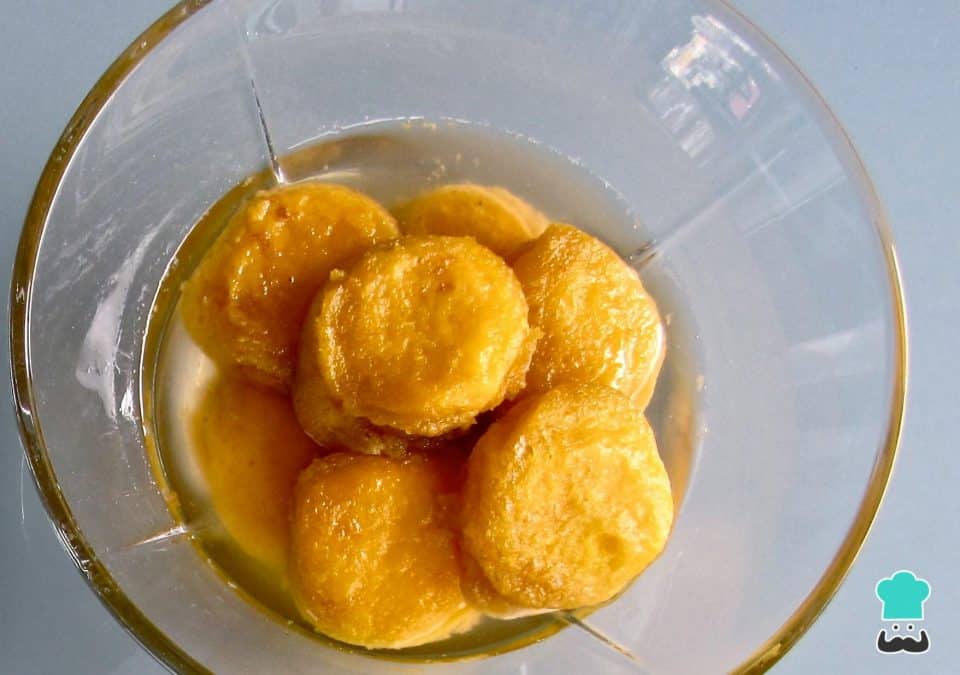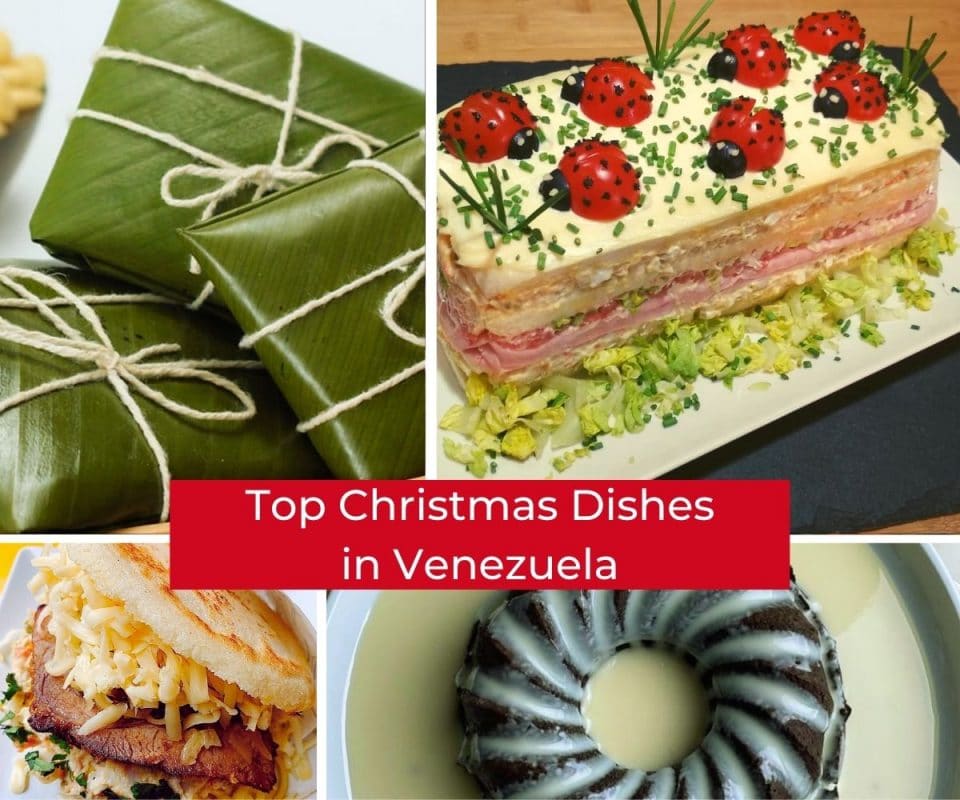15 Most Popular Venezuelan Desserts w/ Recipes

Venezuelan desserts are very diverse and full of flavor. Some have been developed based on native ingredients. In contrast, others are influenced by European cuisine, which left a distinctive mark on local gastronomy. This intriguing mix of New and Old World ingredients is evident in many Venezuelan desserts, making them truly special.
Each dessert has its history, region, and a time or celebration where they are regularly served. You cannot miss the quesillo accompanying the cake for birthdays, while papaya traditionally sweetens the Venezuelan Christmas Eve dinner.
In this article, we will take a tour of 15 mouthwatering Venezuelan desserts most representative of the local cuisine. Enjoy!
1. Negro en Camisa

Negro en Camisa, translated as ‘Black in a shirt‘, is one of my favorite Venezuelan desserts. It is a soft and smooth dark chocolate cake bathed in English cream.
Its name comes from the colors and how this dish is composed, as the English cream (aka custard) represents the shirt. While it’s very popular in Caracas, Venezuela’s capital, it’s little known in the rest of the country.
Many people call this dish the Venezuelan brownie, and they are correct, as the texture and flavor are very similar.
The origins of negro en camisa are debated. Many believe it is of Mantuano origin, a fusion of European and Venezuelan food enjoyed by the local (white) elite in colonial times. But Miro Popic, a renowned researcher of Creole culinary culture, disagrees. He asserts that no chocolate desserts existed in Venezuela until the middle of the 20th century. He believes it’s an imported and adapted dessert from Italy or France.
Regardless of its origin, negro en camisa is simply delicious and one of the many desserts and dishes adopted and adapted to Venezuelan cuisine.
2. Golfeados

Every time I think of describing golfeados, cinnamon rolls spring to mind. The golfeado is a distant cousin of the cinnamon roll since they follow the same principle of a bun rolled up in the shape of a snail. Unlike cinnamon rolls, however, golfeados are filled with grated brown sugar (panela) and cheese and flavored with star anise.
They can be eaten with a piece of ‘cheese of the hand’ that goes on top of the roll, and, for more authenticity, they are accompanied by a very cold malt.
They originated in the country’s capital region. They were said to be the work of the bakers Genaro and María Duarte. They have undoubtedly become one of Venezuelans’ most popular sweets and a must-try for visitors to the country.
3. Quesillo

This is a quintessential dessert that accompanies the birthday cake in Venezuela. It’s related to flan, the hugely popular Latin American dessert.
Quesillo is another Venezuelan dessert with European origins (e.g., the Canary Islands). In the Canary Islands, it is known as flan de huevo and is prepared with milk, egg yolk, and sugar.
In Venezuela, the recipe has evolved. Rather than egg yolk, whole eggs are used in addition to condensed milk. This small but important change makes the texture of the quesillo much lighter due to using whole eggs.
Its name comes from the air bubbles, which make it resemble Swiss cheese. There are chocolate, coconut, coffee, pumpkin, and pineapple versions. If you’re in Venezuela, try them all!
4. Bienmesabe

This is a typical Venezuelan dessert made mainly from coconut and sponge cake bathed in liquor and covered with frosting. It consists of a vanilla sponge cake cut into layers sprinkled with sweet wine, cognac, or rum, alternating with coconut cream layers. It’s decorated with a firm frosting.
There are a couple of stories about the origin of this dessert, both dating back to the colonial era. The first says it was Franciscan nuns who added coconut to the traditional Spanish recipe of Bienmesabe Antequero to give it more flavor. This recipe spread among the ladies of Caracas’s high society thanks to the Franciscan sisters teaching confectionery courses in the convent to get the money to help the needy.
The second version, which is a little more poetic, in my opinion, corresponds to the story of La Negra Contemplación. It is said that no woman in Caracas prepared a better dessert than she did. It was so delicious that many believed this spongy, coconut-flavored cake with a rich coconut cream cured heartache.
5. Dulce de Lechosa

The lechosa is a tropical fruit typical of Latin American countries, where it is known by different names: papaya, mamona, chamburo, melon, sapote, bomba fruit, machauick, mapaña, and higuera (fig) de las Indias.
Papaya is the main ingredient of the sweet that bears its name. It is usually served in December, sweetening Christmas dinner in Venezuelan homes. The fruit is perfectly preserved in glass containers, making it an excellent gift for friends or family.
Green papaya is sliced and cooked in a syrup made with panela (a block of brown sugar) or white sugar. The result is thin sheets of crystallized papaya. This dessert is sometimes made with pineapple, adding a little acidic touch.
6. Torta Negra

Despite not being a recipe of Venezuelan origin, this cake is very popular throughout the country, especially for Christmas. Every time I prepare it, the house is flooded with the aromas of Christmas celebrations.
It’s made with macerated fruits, nuts, a touch of liquor, and in the Venezuelan case, a little cocoa. It is customary to make this cake in December, having soaked the fruit in liquor since January, so it has a year to take on the flavor.
It was introduced to Venezuela from the United Kingdom. It arrived in Latin America on July 28, 1865, aboard the ship Mimosa, which landed on the coast of Puerto Madryn (Argentina). The men and women traveling to seek a new life created this rich dark cake with an extended shelf-life to easily store and transport food.
The Venezuelan version of the original recipe substitutes white sugar for brown sugar and brandy for wine. The addition of a bit of cocoa makes it unique!
7. Arroz con leche

Arroz con leche is a very popular dessert throughout South America, France, Spain, and Mexico. This international sweet has become a tradition in many countries and is characterized by being comforting, especially when eaten warm and with a touch of ground cinnamon.
The main ingredients of this simple dish are rice, sugar, and milk. Venezuelan versions include condensed milk or coconut milk that give it a unique twist.
8. Mermelada de Mango

The mango season in Venezuela is fantastic, as you’ll find mango trees loaded with fruit in every corner of the country, especially in the plains region.
Unripe mangos are used to give the mango jam a firm consistency. Apart from the mango itself, the only things you’ll need to make it are sugar and lemons.
9. Besitos de Coco

Coconut kisses are a cookie that dates back to the early 1700s when pastries began to be prepared with wheat flour.
Like most cookies, they’re easy and fun to make. All you need is all-purpose wheat flour, brown sugar (panela), eggs, grated coconut, baking soda, water, a bay leaf, butter, cinnamon, cloves, sweet pepper, and guayabita grains.
These tropical delights are usually sold on the highways and coasts of the country’s central region. They are particularly popular during Holy Week when you’ll find them everywhere.
10. Buñuelos

Buñuelos de Yuca are one of the iconic sweets of traditional Creole confectionery. They’re a fried and crunchy dessert seasoned with papelón, an unrefined brown sugar drink.
The combination of papelón and the salty part of the cassava makes it one of our Venezuelan culinary culture’s most beloved and representative sweets.
You’ll also find celery, sweet potato, and pumpkin fritters to try.
11. Huevos Chimbos

In the Zulian region you’ll find a typical Creole sweet called huevos chimbos, the local adaptation of Spanish moles eggs.
This dessert is made with eggs, sugar, rum, water, vanilla essence, and butter.
These chimbos ‘eggs’ are made and served all year round, but they are especially popular during the holiday season.
12. Catalinas

Catalinas are one of the most emblematic Venezuelan sweets. They’re sometimes called paledonia, which reflects the Spanish cultural heritage of the country.
They’re made with wheat flour, brown sugar and deliciously spiced with star anise, cloves, and cinnamon (oh, and a little rum).
Catalinas are eaten differently in various parts of the country. In some places, they are eaten on their own. In others, they are accompanied by coffee, while in other areas, they are accompanied by cheese.
13. Chicha Andina

Although many parts of the country think of Chicha Andina as a drink, it is sometimes considered a dessert because it is mainly consumed after meals.
This delicious fermented concoction is made with pineapple shells and rice. It’s spiced with cloves, guayabita, cinnamon, and papelón.
It takes at least eight days to ferment the pineapple, which gives it a characteristically intense flavor.
As the name suggests, you’ll typically find this sweet drink in the Andean region of Venezuela. If you can try it -it’s unique and unforgettable!
14. Majarete

Majarete is a sweet Lent and Easter dessert with an unmistakable Venezuelan imprint. It is made with corn flour and coconut and flavored with cinnamon, cloves, and lemon. Panela or papelón sweetens it up.
The majarete has humble origins. Although the appearance is nothing to get excited about, it is one of those sweets that steals your heart. It conjures nostalgic pictures of rural Venezuela: the bahareque houses, kitchens with wood stoves, humble families with limited resources, and very basic, cheap ingredients.
Initially, before the invention of precooked flour, parboiled corn dough was used. The coconut was ground or grated and mixed with hot water to extract the milk, and the brown sugar, panela, was grated. Like many traditional recipes, it required a lot of work.
Majarete has a smooth consistency, although it shrinks once it cools down. This sweet does not require variations or additions; you can’t put whipped cream or a strawberry on top to make it look cute because it doesn’t look good in photos. It is also not worth thickening it with cornstarch or flour to make it custard.
The ingredients are austere, as is its origin, and there lies its beauty and value.
15. Palmeritas

Puff pastry palmeritas are a very popular sweet in all bakeries and pastry shops in Venezuela.
The base of this sweet is puff pastry, a dough of flour and butter (margarine or lard) made by layering many thin sheets.
The palmerita was originally a French specialty (in French, palmier). Palmeritas are usually around 2-4 centimeters thick and have a specific heart shape.
There are also different versions: traditional ones with sugar, those with egg yolk, and those with chocolate, usually milk chocolate.
So, that ends our tour! We hope you have seen that the variety of Venezuelan sweets and desserts deserves exploring. With their range of flavors and diverse influences, there’ll always be a dessert for every palate. And the most beautiful thing of all, each Venezuelan dessert is made to enjoy with family and friends.
Have we included all your favorite Venezuelan desserts? If you have more suggestions for our community to try, leave us a comment below! We love to hear from you!
Related: Most Popular Venezuelan Foods
Related: Most Popular Christmas Dishes in Venezuela



Great recipes thank you. I need to make some, had forgotten about them. They are all delicious
Bueno el negro en camisa no es de los más populares, el bienmesabe de coco no es así como se preparada, la chicha no es un postre es una bebida, por favor si vas a escribir de Venezuela infórmate más y mejor, gracias.
Excellent of you, Reny, to share these wonderful and loved recipes of Venezuela. You make your countrymen proud!